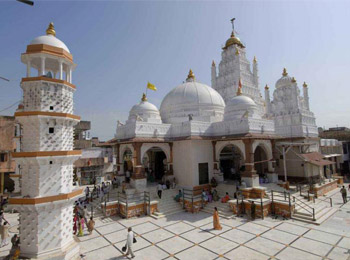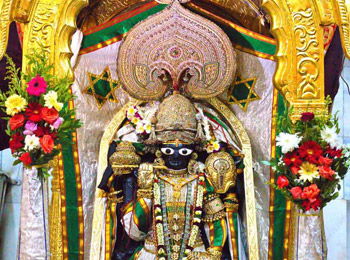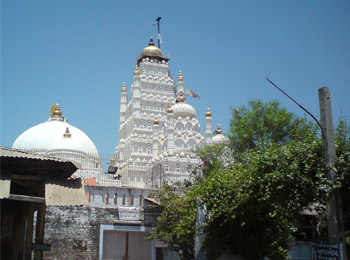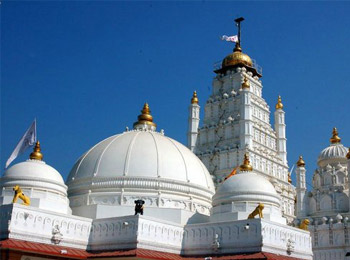- Vishnu
Ranchhodraiji Temple
- Dakor,Gujarat
- View on map
- Tell us about this temple
Overview
The Sri Dwarkadhish Ranchhodrai Temple, in Dakor is the habitat of God Krishna, the seventh symbol of God Mahavishnu. Dakor city is situated in the Kheda District of Gujarat State in India. The spot is unmistakable for its fabulous temple of Shree Ranchhodraiji. The sacred place that is known for Dakor is joined through rail and street to numerous spots and Dakor station lies on the Anand-Godhra Rail course. Dakor is at a separation of around 90kms from Vadodara city.
About the Temple

The present temple was developed by Shri Gopalrao Jagannath Tambwekar in 1772 A.D. at the expense of rupees one lakh. It was manufactured with block dividers and stones columns. It is raised on a high plinth of 168 feet by 151 feet with twelve stone strides on every side and encompassed by a roomy patio. It has eight vaults and twenty four turrets, the most noteworthy of them being 90 feet making it the tallest temple in the region.
The primary entryway of the temple neglects the (now swarmed) banks of the lake Gomati. Silver doors are secured by the Vedic Gods - God Ganesha, Sun, Moon, and so forth delightfully cut in high alleviation. The door leads into the principle patio. As custom would have it, drummers sit on the principle entryway in their very own overhang. The ''Nagarkhana'' resounds with music amid the principle darshans and at Aarti times. On entering the patio, one sees two tall structures, used to house a huge number of lights that are lit amid the bubbly season, on either side. Multi-storied and multi-layered, this sort of structure is extremely regular of medieval Gujarati temple construction modeling.
Back at the front door, marble stairs lead to the primary group of onlookers council of the temple - the Jagmohan - truly the spot where the world is enchanted (by the excellence of the God). Three expansive doors permit dedicates to enter the principle crowd chamber. The expansive open square structure of the group of onlookers chamber is surmounted by a forcing, sparkling arch. Till as of late, the arch was painted with Shri Krishna's rasa-lila in the established Bundi style. As of late, this has been supplanted by a complicated decorate of mirror work, delineating blossoms and trellis in an established Rajput garden. Painted wall hangings from God Krishna's life embellish the dividers of the gathering of people chamber. A little area at the front of the chamber is railed off and saved for ladies.
Likewise with every single traditional temple, the inward sanctum of Ranchodrai is set in a straight line from the primary entryway of the temple. The God sits under a canopied structure in the internal sanctum. The entire structure is raised on a marble stage and the mainstays of the structure are secured in gold. The unpredictably cut entryways and windows to the internal sanctum are secured in silver. There are three entryways driving into the inward sanctum. Ways to one side of the God roll in from the waiting room, prompting an exceptional washroom where the clerics must bathe before entering the internal sanctum. Halls from here, additionally prompt the fortune place of the God - lodging His in-numerable gems and garments. The entryway before the God confronts the principle group of onlookers chamber.
At Dakor, the God invests however much energy as could be expected with His aficionados. The primary ways to the inward sanctum are open a large portion of the day. The entryways just close when the God dozes - amid the evening and during the evening. The way to one side of the God prompts the bedchamber of the God - a reflected council of thousand enjoyments. Different beds, sleeping cushions and covers are conveniently organized in here for the God's solace. Silver and gold bedsteads are secured in delicate cottons and silks. Fragrances and laurels are kept in availability for the God. A little hallway leads from here to the open corridor behind the bedchamber, where travellers perform different religious ceremonies to satisfy the God.
As at Badrinathji in the Himalayas and Tirupati Balaji in South India, at Dakor, the temple of Goddess Lakshmi, wife of the God, is arranged outside the principle temple. Lakshmiji's temple is arranged in a private piece of town at a little separation from the primary temple. It is trusted that the God visits His wife on each Friday - on Fridays an elegant parade wind its way from the fundamental temple down the paths and bylanes of Dakor to unite the couple. The present temple complex is set in an expansive square setting. Four entryways penetrate the external dividers at the cardinal focuses. Different workplaces and storerooms are set around the external border of the temple. The genuine temple is determined to a high stage in a mind boggling, set in the style of medieval sanctuaries from the area. Amid celebrations, the hands encased in gloves of gold studded with jewels.
About the Deity

The type of God Ranchhodrai is that of the God Vishnu with four arms. As the God here is adored more as Krishna than Dwarkadhish, i.e. more youthful and more liberated than the experienced God of Dwaraka, His right hand is regularly demonstrated to hold a woodwind - a most loved instrument of the God in His more youthful days. The upper right hand holds the mace, the upper left hand holds the disk and the lower left hand holds the conch. Customarily, it is hard to see these ''ayudhas'' of the God in His grasp.
Legend and Stories

In times of Mahabharata, the encompassing zone of Dakor constituted the 'Hidamba' van (wilderness). It was an extremely thick wilderness. It was lovely and rich with streams and lakes. It had turned into a fascination for the sages to build up their seclusion for retribution. In like manner, Dank Rishi had his isolation (ashram) around there. Amid compensation God Shiva was satisfied with him and requesting that he request something. Immediately, Dank Rishi asked for God Shiva to remain for all time in his isolation. God Shiva consented to his solicitation. He vanished and deserted him His copy as Ban (Ling), which is known as Danknath Mahadev. In this way in old times, Dakor was known as 'Dankor' after the name of Dankanth Mahadev. It was otherwise called khakhariya on account of numerous khakhra(palash) trees in the region.
The present Dakor owes its raison not to Dank Rishi but to Bodana, a great devotee of Lord Krishna. In his previous birth, he is supposed to have lived in Gokul and been a cowherd called Vijayanand. On one 'Holi' day, all the cowherds except Vijyanand worshipped Lord Krishna. His wife too worshipped Lord Krishna. But Vijayanand was proud and stayed at home. Lord Krishna came to his house in disguise of his friend and sent him to perform 'Holi' puja. Coming back, he realised that his friend was none else but Lord Krishna. Next day they fought a battle of colour. Lord Krishna lost and fell into the river. Vijyanand went after him where Lord Krishna revealed his true self. Vijyanand begged forgiveness. Lord Krishna took pity on him and solaced him with a boon that he would be born in Gujarat again in Kaliyug after 4200 years as Vijayanand Bodana in the house of a Krishatriya and his present wife Sudha would again be his wife, called Gangabai, when he will give them a glimpse (darshna) and relieve them by offering them emancipation (Moksha).
So as the legend would have it, 'Vijayanand Bodana', a rajput of Dakor, becomes a staunch devotee of Lord Krishna. He used to let the basil plant (Tulsi) grow in an earthen pot with him on his palm and used to go every six months to Dwarika to worship Lord Krishna with the said Tulsi leaves . He did this continuously, unfailingly and untiringly till he was 72 years he then began to find it increasingly difficult to pursue this ritual. Seeing his plight, Lord Krishna told him that on his ensuing visit to Dwarika, he should bring a bullock-cart with him and Lord Krishna would accompany him to Dakor as he was exceedingly pleased with his devotion.
Accordingly, Bodana went with bullock-cart to Dwarika. The hereditary priests of Dwarika (Gugli brahmins) asked him as to why he had brought a cart with him. Whereupon, Bodana replied that he had done so to take away Lord Krishna. Looking to the ramshackle cart, they did not believe him but nevertheless locked and sealed the sanctum sanctorum of Dwarika Temple for the night. At mid night, Lord Krishna broke open all the doors, awoke Bodana and told him to take him to Dakor. Shortly afterwards, Lord Krishna called upon Bodana to rest in the bullock-cart and drove the cart himself till reached the vicinity of Dakor. Here (near Bileshwar Mahadev on Dakor-Nadiad road) they rested for some time, touching and holding a branch of neem tree. He woke up Bodana and asked him to take over. Since that day, this neem tree is found to have one sweet branch though the rest of the branches are bitter and it forms the subject of a well-known Gujarati song (bhajan).
In Dwarika, the Gugli brahmins finding the image missing chased Bodana and came to Dakor in pursuit. Bodana was frightened but Lord Krishna told him to hide the idol of the deity in the Gomti tank and meet the Guglis. Accordingly, Bodana hid the idol and went to meet the Guglis with a pot of curd to pacify them. They became angry and one of them threw a spear at him. He fell down dead While hurting Bodana with a spear it also hurt the image of the deity hidden in Gomti tank and the water turned red with Lord Krishna's (Ranchhodraiji's) blood. It is said that even today the earth of Gomti tank where the image lay is red while rest of the tank is of brown mud. In the midst of Gomti tank, over the place where Lord Krishna was hidden, a small temple having the Lord's foot-prints is constructed and this temple is linked with the bank of Gomti Tank by a bridge.
Even with the death of Bodana, the Guglis were not appeased. Requesting Lord Krishna to return to Dwarika, they sat on the bank of Gomti tank and went on a hunger strike. At last, Lord Ranchhodraiji (Krishna) directed Gangabai, wife of Bodana, to give gold equivalent of his weight and ask the Guglis to return to Dwarika. Poor lady, the widow of Bodana, was a pauper and could not afford doing so. By a miracle, the idol became as light as a golden nose-ring (1, 1/4 val i.e.1/2 gram in weight) which was all that the widow of Bodana, Gangabai, had. The Guglis were disappointed but the Lord mercifully directed that they would find after six months an exact replica of the idol in Sevaradhan Vav (well with steps) at Dwarika. The impatient Guglis looked for the idol sometime earlier than they were told and as a result, found an idol which, though similar to the original one, was smaller, Pilgrims to Dakor still visit the places stated to have been associated with the legend viz. Where the branch of neem tree under which Lord rested while coming to Dankpur subsequently turned sweet; where the idol was hidden in the Gomti tank; whereon the balance was set up to weigh the original idol which Bodana had enshrined.
Daily Darshan Timing
Morning Time
- Mangala Darshan - 06:45 AM to 08:10 AM
- Bal Bhog Darshan - 08:30 AM to 09:00 AM
- Shrungar Darshan - 09:30 AM to 10:00 AM
- Gval Bhog Darshan - 10:15 AM to 10:30 AM
- Raj Bhog Darshan - 11:30 AM to 11:45 AM
Evening Time
- Uthhapan Darshan - 04:15 PM to 05:00 PM
- Shayan Bhog Darshan - 05:25 PM to 06:15 PM
- Shakhdi Bhog Darshan - 07:00 PM to 07:30 PM
Sunday Darshan Timing
- 06:45 AM to 08:30 AM
- 09:00 AM to 10:30 AM
- 11:15 AM to 12:15 PM
- 04:15 PM to 07:00 PM
Daily Rituals
There are 5 darshans between 6.45 a.m to 12 Noon. Namely Mangla, Bal bhog, Srinagar bhog, Gwal bhog and Rajbhog during which Aartis are performed. For the post lunch session, it reopens at about 4.15 P.M. and closes at 7.30 P.M. Between which there are three darshans namely, Usthapan, Shyan and Shakhdi bhog. For Utthapana Bhoga and Shayana bhoga Aaratis are performed. The Darshana timings on Full -Moon days are different and are announced by the temple authorities beforehand. For the convenience of the vaishnavas desirous to offer additional bhogs to the deity except the scheduled ones, there is a provision in the Dakor Temple Scheme and accordingly Mahabhog, Rajbhog and additional bhogs are offered to the deity. For all such extra Bhogs the devotees can receive prasad except Rajbhog, through Dakor Sansthan Trust which is the oldest Bhog of the time when the Deity Shree Ranchhodraiji was installed in this temple i.e. when the Pran Pratishtha was performed.
Mangla
Mangala Darshan is the first darshan of the day at dawn. The Bhavana (emotion) of waking Lord Ranchhodraiji with the same affection and love of his mother Yashoda, when at Gokula is represented in this Darshan. The name Managla underlines the auspiciousness of beginning the day with a glimpse of the Lord.
Shringar
Shringar Darshan is usually 45 minutes after the Mangala Darshan. His attire depends on the day and the month according to the Lunar Calendar. Ranchhodraiji is adorned with a garland of flowers around his neck. The lord is shown a mirror to see himself. He is offered dry fruits and sweets after which the flute is placed over his shoulder to imply that the Lord can now go out to play with his friends.
Gwal Bhog
After the Shringar Darshan, is a Gwal Darshan during which the Lord takes his mid-morning snack,Curds and light food is offered to him during this darshan. Gwal darshan depicts the time when Lord Ranchhodraiji takes his cows to the pasture and plays with his friends. Neither garland nor flute is placed on his shoulder as he is playing with his cowherd friends.
Rajbhog
The main meal of the day is offered to Ranchodraiji during this darshan. He is adorned with lotuses, a flower garland and his flute. Perfume of the season is sprinkled. The sounds of drums and devotional music fill the air and the excitement mounts as the Aarti is performed. After this, he retires for three hours representing the siesta he enjoyed in the meadows.
Utthapan
In the Utthapan darshan which is at mid afternoon, Lord Ranchodraiji is lovingly awakened from his afternoon nap.
Shayan
The Shayan Darshan is the last Darshan of the day, when Lord Ranchodraiji finishes a light meal. A fan made of peacock feathers is waved to avoid the effects of any evil eye cast while he is in full view of the people.
Rare Facts
God Krishna here is loved more as Krishna than Dwarkadhish, i.e. more youthful and more liberated than the full grown God of Dwaraka. Lord Krishna and Bhim were once going to visit the sacred thread-ceremony of Parikshit, the grandson of Arjun and son of Abhimanyu. On their way, while passing the jungle, Bhim became thirsty and was on the lookout for water. Lord Krishna pointed out a basin near the hermitage of Dank Rishi. Both of them went there and quenched their thirst. Thereafter they were resting under the shades of trees. Bhim thought that if this basin was made big it would quench the thirst of wild animals, birds and human beings. With a stroke of his club, Bhim converted the basin into a big pond spreading over an enormous area of 572 acres and this is at present is known as Gomti Tank. It is situated just opposite the Ranchhodraiji Temple. It is one of the biggest village tanks in Kaira District with masonry walls, Outlets and stone steps on the sides.
Accessibility
Airport
The closest airport is Sardar Vallabhbhai Patel International Airport which is located in Ahmedabad.
Railways
The closest junctions are in Dakor, Anand, Godhra.
Road
State Transport and Luxury buses are available from Ahmedabad and Vaodara.
Temple Address
Shree Ranchhodraiji Maharaj Mandir,
Dakor, Dist: Kheda, Gujarat,
India, Pincode – 388225.
Significance
Devotees visit this temple to seek fulfillment of the following:-
- General prosperity
- To get married
Shlokas
Achutham Keyshavam Rama Narayanam Krishna Damodaram Vasudevam Harim Shridharam Madhavam Gopika Vallabham Janaki Nayakam Ramachandram Bhajey
Meaning -Oh Lord who cannot be perished, who also has names like Keshava, Rama, Damodara, Narayana, Sridhara, Madhava, Krishna, Ramachandra the beloved of Janaki, let me say your name regularly.
Vasudeva Sutham Devam Kamsa Chanoora Mardhanam Devaki Paramanandham Krishnam Vande Jagathgurum
Meaning -I bow to you O Krishna, the ultimate guru, Devaki and Vasudeva's son, and the destroyer of Kamsa and Chanur.
Adharam Madhuram Vadanam Madhuram Nayanam Madhuram Hasitam Madhuram Hridayam Madhuram Gamanam Madhuram Mathuraa Dhipate Rakhilam Madhuram
Meaning -Meaning - Sweet are Your lips, sweet is Your face, sweet are Your eyes, sweet is Your smile, sweet is Your heart, sweet is Your gait, O Lord of Mathura, everything about You is sweet.
Alokya Mathur Mukha Madarena Sthanyam Pibantham Saraseeruhaksham Sachinmayam Devam Anantha Roopam Balam Mukundam Manasa Smarami
Meaning -I think of this Balamukundan as the one who looks lovingly at his mother's face while taking milk from her, who has eyes similar to the red lotus, who is the embodiment of truth and intelligence and other forms.
Timings
The temple is open from 06:45 am to 12:00 pm and 04:00 pm to 07:30 pm.
